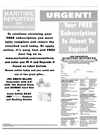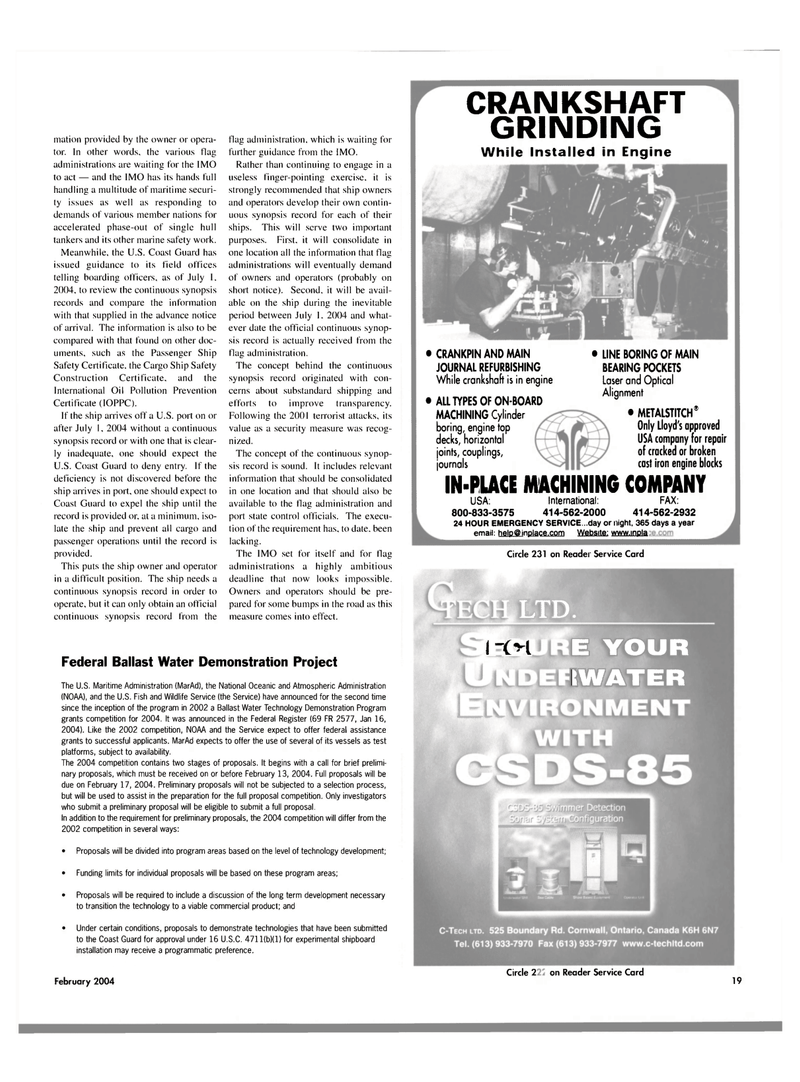
Page 22: of Maritime Reporter Magazine (February 2004)
The Tanker Yearbook: ATB Edition
Read this page in Pdf, Flash or Html5 edition of February 2004 Maritime Reporter Magazine
mation provided by the owner or opera- tor. In other words, the various flag administrations are waiting for the IMO to act — and the IMO has its hands full handling a multitude of maritime securi- ty issues as well as responding to demands of various member nations for accelerated phase-out of single hull tankers and its other marine safety work.
Meanwhile, the U.S. Coast Guard has issued guidance to its field offices telling boarding officers, as of July I. 2004, to review the continuous synopsis records and compare the information with that supplied in the advance notice of arrival. The information is also to be compared with that found on other doc- uments, such as the Passenger Ship
Safety Certificate, the Cargo Ship Safety
Construction Certificate, and the
International Oil Pollution Prevention
Certificate (IOPPC).
If the ship arrives off a U.S. port on or after July 1, 2004 without a continuous synopsis record or with one that is clear- ly inadequate, one should expect the
U.S. Coast Guard to deny entry. If the deficiency is not discovered before the ship arrives in port, one should expect to
Coast Guard to expel the ship until the record is provided or. at a minimum, iso- late the ship and prevent all cargo and passenger operations until the record is provided.
This puts the ship owner and operator in a difficult position. The ship needs a continuous synopsis record in order to operate, but it can only obtain an official continuous synopsis record from the flag administration, which is waiting for further guidance from the IMO.
Rather than continuing to engage in a useless finger-pointing exercise, it is strongly recommended that ship owners and operators develop their own contin- uous synopsis record for each of their ships. This will serve two important purposes. First, it will consolidate in one location all the information that flag administrations will eventually demand of owners and operators (probably on short notice). Second, it will be avail- able on the ship during the inevitable period between July I. 2004 and what- ever date the official continuous synop- sis record is actually received from the flag administration.
The concept behind the continuous synopsis record originated with con- cerns about substandard shipping and efforts to improve transparency.
Following the 2001 terrorist attacks, its value as a security measure was recog- nized.
The concept of the continuous synop- sis record is sound. It includes relevant information that should be consolidated in one location and that should also be available to the flag administration and port state control officials. The execu- tion of the requirement has, to date, been lacking.
The IMO set for itself and for flag administrations a highly ambitious deadline that now looks impossible.
Owners and operators should be pre- pared for some bumps in the road as this measure comes into effect.
Federal Ballast Water Demonstration Project
The U.S. Maritime Administration (MarAd), the National Oceanic and Atmospheric Administration (N0AA), and the U.S. Fish and Wildlife Service (the Service) have announced for the second time since the inception of the program in 2002 a Ballast Water Technology Demonstration Program grants competition for 2004. It was announced in the Federal Register (69 FR 2577, Jan 16, 2004). Like the 2002 competition, N0AA and the Service expect to offer federal assistance grants to successful applicants. MarAd expects to offer the use of several of its vessels as test platforms, subject to availability.
The 2004 competition contains two stages of proposals. It begins with a call for brief prelimi- nary proposals, which must be received on or before February 13, 2004. Full proposals will be due on February 17, 2004. Preliminary proposals will not be subjected to a selection process, but will be used to assist in the preparation for the full proposal competition. Only investigators who submit a preliminary proposal will be eligible to submit a full proposal.
In addition to the requirement for preliminary proposals, the 2004 competition will differ from the 2002 competition in several ways: • Proposals will be divided into program areas based on the level of technology development; • Funding limits for individual proposals will be based on these program areas; • Proposals will be required to include a discussion of the long term development necessary to transition the technology to a viable commercial product; and • Under certain conditions, proposals to demonstrate technologies that have been submitted to the Coast Guard for approval under 16 U.S.C. 4711(b)(1) for experimental shipboard installation may receive a programmatic preference.
February 2004
CRANKSHAFT GRINDING
While Installed in Engine • CRANKPIN AND MAIN
JOURNAL REFURBISHING
While crankshaft is in engine • ALL TYPES OF ON-BOARD
MACHINING Cylinder boring, engine fop decks, horizontal joints, couplings, journals • LINE BORING OF MAIN
BEARING POCKETS
Laser and Optical
Alignment • METALSTITCH ®
Only Lloyd's approved
USA company for repair of cracked or broken cast iron engine blocks
IN-PUCE MACHINING COMPANY
USA: International: FAX: 800-833-3575 414-562-2000 414-562-2932 24 HOUR EMERGENCY SERVICE...day or night, 365 days a year email: hfiic^jneiaiaLjam Webstle; amuDBla
Circle 231 on Reader Service Card
LTD.
I -OI E YOUR
K WATER
Circle 236 on Reader Service Card 19

 21
21

 23
23
